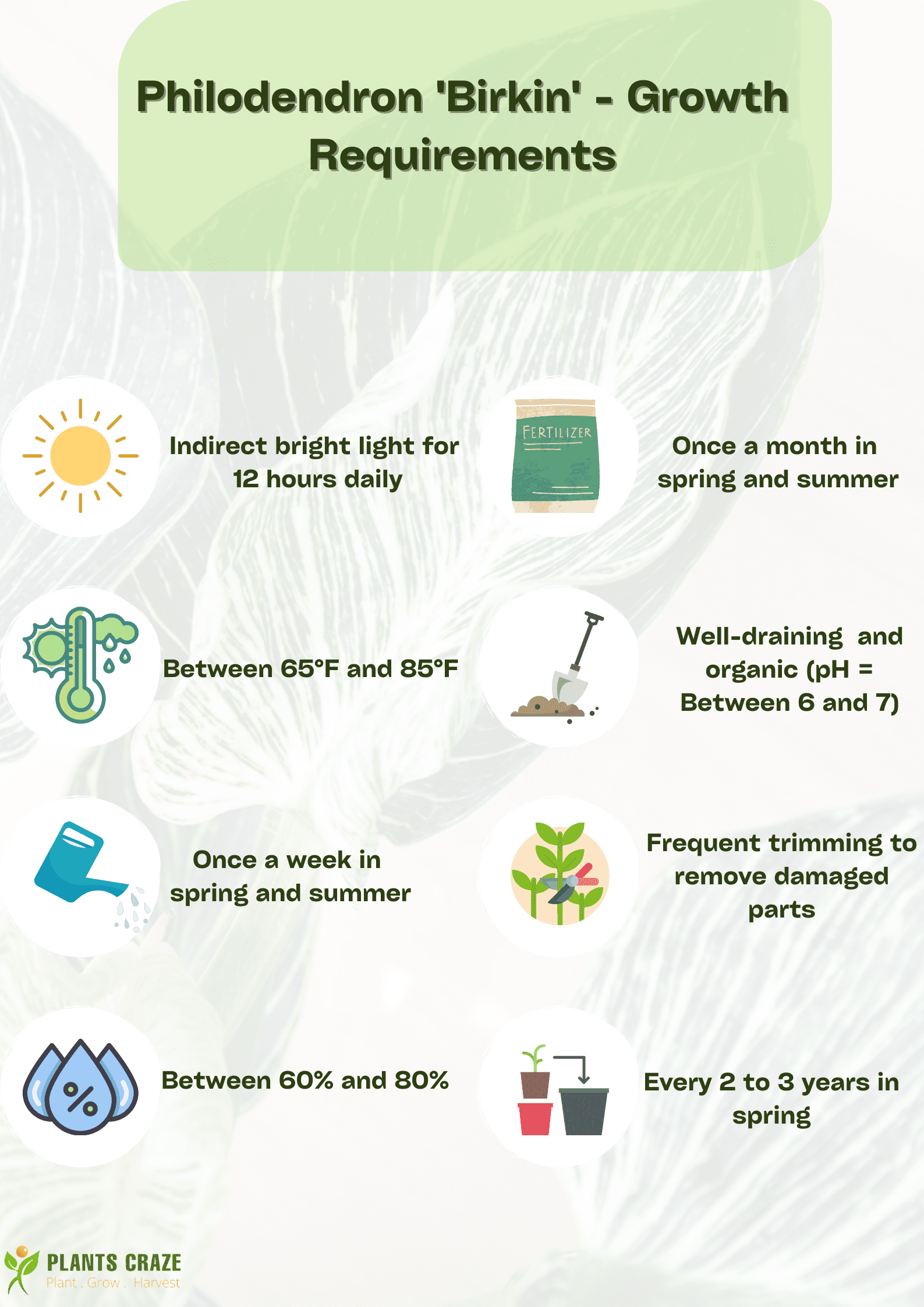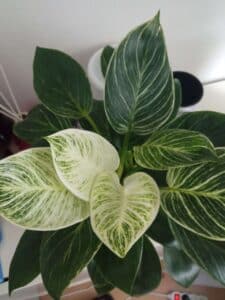Have you noticed that your Philodendron birkin has shaded its yellow leaves unnaturally in the spring? Watch the plant with a care checklist and learn which need you have missed offering.
Philodendrons are laid-back about most basic needs, but the plant is sensitive about a few things you should not refrain from. Let’s know about them!
Table of Contents Show
Overview of Philodendron Birkin
Philodendron birkin is a designer plant from crossbreeding between equally beautiful Philodendron ‘Congo’ and Philodendron ‘Imperial Green.‘
Native to Brazil, Philodendron birkin is from the Araceae family, with more information in the table below.
| Feature(s) | Description(s) |
|---|---|
| Common Name | Philodendron "White Wave" or White Wave |
| Scientific Name | Philodendron birkin |
| Ecology | Lifespan: Evergreen Perennial Habit: Non-vining Shrub Red-List Category: None (as it is a hybrid cultivar) Invasiveness: None Habitat: Tropical Rainforests |
| USDA Hardiness Zone | Can thrive from USDA zones >10 |
| Growth Rate | Slow to Moderately Fast |
| Plant Size | 3 feet tall and wide |
| Growth | Season: Spring to Summer (March to August) Maturity: Takes around 10 years (Growth slows down in fall and winter) |
| Leaf Traits | Size: 20 centimeters long Color: White when young that matures to dark green with white stripes Shape: Oval-shaped with pointed tips Texture: Glossy or Waxy |
| Flowers | Season: Summer (June to July) Occurrence: Rare Inflorescence: Spathe and Spadix |
| Grown For | (Leaf) Home Décor |
| Toxicity | Toxic to both pets and humans |
| Specialty | Elegant patterned leaves Plant is a hybrid formed by crossbreeding |
Philodendron Birkin: A Detailed Guide
Philodendron birkin is a tropical plant requiring similar basic demands that other tropical aroids need.

1. Light & Temperature
Since Philodendron birkin is a hybrid between two tropical Philodendron varieties, it demands a similar tropical environment.
If it is the winter season, only 4 to 6 hours of direct sunshine will be enough. Also, bring it back inside to protect it from frost injuries.
In their natural home, Philodendrons like to stay under the shade of tall trees and only receive enough sunlight through the canopies of tall trees.
Keeping this in mind, you can also locate your plant beside an east-facing window or about three feet away from the south-facing windowsill.
Philodendrons can develop the leaves to droop and scorch their tips, with colors disappearing if the temperature increases beyond the optimum level.
Also, they can undergo slow growth due to low light and temperatures below 50°F.
To shield your Philodendron from cold, cover them using frost blankets in winter or when the plant is outside.
2. Water & Humidity
Philodendron birkin can hold on its own for a week or two without water, depending on the season.
Underwatering causes the leaves to curl and bend while the stem sag, but the plant may recover quickly if immediate watering is offered.
Like other tropical plants, Philodendron birkin does not tolerate waterlogging, being prone to root rot.
In cold spells, the plant stays dormant and only requires biweekly watering.
To prevent overwatering, check the top 1 to 2 inches of soil for dryness by giving a finger dip test and wait for the soil to dry between the watering bouts in hot and cold seasons.
Additionally, if the humidity levels are below 50%, place the plant on a pebble tray or install a humidifier. You can also locate the plant in a well-lit bathroom or group it with other houseplants.
3. Soil & Fertilizer
Hard-textured soil saturates fast, causes root rot, and prevents the roots from going deeper and breathing freely.
On the other hand, Philodendron birkin may succumb to underwatering if the soil is too airy.
You can choose any trusty commercial-grade fertilizers and potting mixes from the table below.
Continuous fertilizing can also accumulate fertilizer salts in the soil, causing leaf tip curl and marginal leaf burns.
To prevent this, cut back fertilizer in fall and winter, leach out the excess salts by running the plant under distilled water, and grant correct concentrate fertilizer.
You can also make a DIY potting mix by blending garden soil, sand, compost, and coco coir, in a ratio of 1:1:1:1.
4. Potting & Repotting
If the roots poke from the drainage holes, crowd on the topsoil, water logs in the soil or growth stunts, it’s a clear sign to repot Philodendrons.
Water it 1 to 2 days before repotting to ease the soil. Loosen the plant by tapping the pot from the sides and take out some topsoil.
Grab the plant by the stem and gently pull it out. Take a clean, new pot and then fill it with fresh soil at the bottom.
Untangle the roots from the soil clumps, prune any damaged parts, and place the plant in the middle of the new pot while adding soil from the sides up to 1/2 inch below the brim.
Water thoroughly to soak the plant with the root’s depth and give it a few weeks to recover.
5. Frequent Pruning
Although Philodendron birkin is a slow grower, it still needs frequent trimming.
Pests like spider mites, mealybugs, thrips, and scales irritate Philodendron birkin, while brown leaf spots and root rots can be problematic due to bacteria and fungi.
You can remove the infected or infested parts above the ground through pruning.
If the leaves are beyond saving, consider snipping them using sterilized pruners right at the base where the leaves connect the stem.
Also, you can spray copper-based fungicides to treat Philodendron diseases.
You can also cast away the pests and their eggs hidden behind the leaves with gentle water sprays or scrub them off using q-tips soaked in neem oil.
Philodendron Birkin: All About Growth Rate
Philodendron birkin is a slow to fast grower and takes at least 10 years to grow into a mature size of around three feet.
When young, the leaves are white but become darker green and speckled with white stripes as the plant matures.
At maturity, the leaves are around 20 centimeters long, oval-shaped, and have pointy tips with distinctive variegation.

Sometimes, the plant may not get those variegated leaves and beget simple leaves. To cheer them for growing variegated leaves, you must cut away the non-variegated ones.
Leaf color also depends on the season and requirements. The plant may get white leaves in fall and winter as fertilizer and watering are kept on hold.
Besides, the Philodendron birkin enters flowering maturity very late in its lifecycle, with greenish-white ‘Spathe‘ and creamy white ‘Spadix‘ inflorescence.
Spadix braces small flowers helping in reproduction and seed production, while Spathe continues pollination.
Toxicity of Philodendron Birkin
Like all Philodendrons, Philodendron birkin contains calcium oxalate crystals to reflect toxicity.
Your pets may suffer from mouth irritation, excessive drooling, vomiting, and breathing difficulties upon nibbling the leaves or plant parts.
Philodendron birkin is also toxic to touch or rub the leaves.
Symptoms like skin rashes, swelling, and blisters appear on touch, while ingestion may cause vomiting, diarrhea or oral irritation in humans.
Milk contains calcium that helps fight the oxalate crystals, and drinking it will call for some relief.
If such symptoms persist or take a long time to ease, immediately contact any of the helplines below.
Propagation Methods for Philodendron Birkin
There are multiple methods to propagate Philodendron birkin, but stem cutting is among the most popular and successful practices.
Normally, spring or early summer is the right time to take the cuttings from a healthy Philodendron plant.
Philodendron birkin rarely flowers, so its seeds are not a good option for propagation.
1. Propagation via Stem Cuttings
Take a 3 to 6 inches long healthy stem cutting with 2 to 3 leaves at the top and remove all the lower leaves to expose the nodes.
Make a 45° angled cut at the end and place the cuttings in a jar filled with rooting hormone solution.
- Cover the cuttings with a plastic bag, locate them in bright indirect sunlight, and replace the water every 3 to 4 days.
- When roots sprout about 1 to 2 inches in 2 to 4 weeks, transplant the cuttings about 2 to 3 inches deep in well-draining soil by considering light, temperature, and humidity needs.
- Keep the soil moist until new leaves arise in 1 to 3 weeks.
2. Propagation via Layering
Layering saves you from the double shift work to take stem cuttings and puts less stress on the plant.
Select a healthy stem, and make a shallow vertical 2 inches long cut along the length of the stem. Pop it open by fixing a toothpick in the cut.
- Wrap the cut with wet coco coir or peat moss and secure it with string.
- Cover the setup with plastic wrap to maintain humidity and temperature, and keep it in dappled sunlight.
- The cuttings will develop 1 to 2 inches long roots within 1.5 to 2.5 months, after which you can snip this rooted section an inch below the point of root growth.
- Place this cutting in well-draining soil about 2 to 3 inches deep and water to keep the soil moist.
- New leaves shall crop up in 1 to 3 weeks; after that, you can follow normal care.
You can watch this video to revise the process of propagating Philodendron birkin.
Philodendron Birkin vs. Green Princess & Rojo Congo
Since Philodendron birkin is a hybrid, it shows common featural impressions with Philodendron “Green Princess” and Philodendron “Rojo Congo.“
All three varieties grow under similar tropical conditions and possess equally glossy leaves with identical shapes.
Also, they show erect growth habits with rare flowering and the same inflorescence.
Also, all these varieties contain calcium oxalate in the plant parts.
These three varieties share only one difference in leaf color.
| Philodendron Varieties | Leaf Color |
|---|---|
| Birkin | Mottled with white and green stripes |
| Rojo Congo | Chocolate brown to coppery red |
| Green Princess | Dark green |
FAQs About Philodendron Birkin
Does Philodendron birkin purify the air?
According to NASA, Philodendron varieties purify the air and effectively remove toxins from the air, but some types can do it better than others.
Why is my Philodendron birkin reverting?
Philodendron birkin can revert its stripey green leaves to fully white due to a lack of suitable sunlight. You can fix and prevent it with regular care.
Wrapping Up
Philodendron birkin is a rare variety with glossy green leaves blazed with creamy white or yellow pinstripes.
Aroid fans can leverage this houseplant as a designer plant, along with many medical benefits.
But you must be careful while touching or caring for the Philodendron birkin, especially barring it from pets and children.


